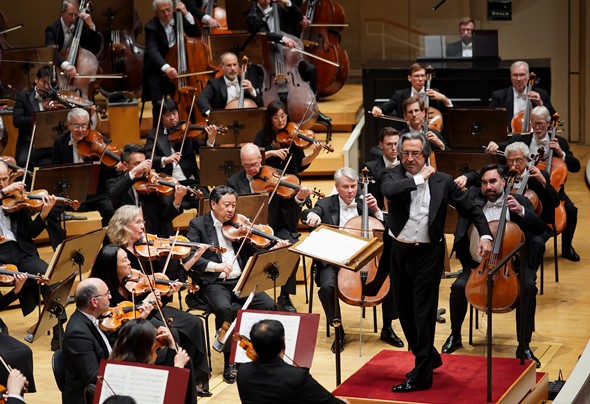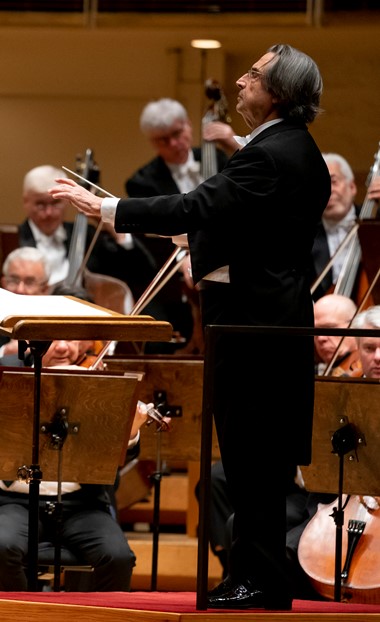Chicago Symphony, its fabled sound blazing, gets wild welcome in return to Orchestra Hall

Music director Riccardo Muti led the Chicago Symphony Orchestra’s return concert at Orchestra Hall on May 2 after a seven-week strike. (Concert photos by Todd Rosenberg)
Review: Chicago Symphony Orchestra conducted by Riccardo Muti; Joyce DiDonato, mezzo-soprano. Repeats May 4 and 7.
By Lawrence B. Johnson
O say, can you see – the Chicago Symphony Orchestra is back, its seven-week strike over, music on the stands and music director Riccardo Muti once more presiding from the podium. To a whooping, standing-O reception, the CSO roared back into action at Orchestra Hall on May 2 with a performance that made clear the orchestra, in a twinkling, was all the way back: a full-fledged do-over.
And lest anyone miss the point that, even at the three-quarter mark of the season, this was in spirit a restart, Muti began with a flick of his baton for a drumroll and struck up “The Star-Spangled Banner.”

Mezzo-soprano Joyce DiDonato brought intensity and brilliance to Berlioz’s “The Death of Cleopatra.”
Muti, who likewise got a vociferous welcome from the audience, made no speeches. No platitudes about how great it was to have these wonderful musicians again doing what they do so well. He let the Chicago Symphony remind the faithful of why they care, and of just what a treasure beyond price is theirs.
The showcase program, on a Roman theme, began with a substantial, albeit nearly forgotten, symphony by Bizet that posthumously acquired the titled “Roma,” which the CSO last performed under its founder, Theodore Thomas, in 1894. A repertoire staple, Respighi’s “Pines of Rome,” capped the night in spectacular fashion. But in between came the jewel of the occasion, Berlioz’s concert monodrama “The Death of Cleopatra,” delivered up by mezzo Joyce DiDonato with all the intensity, theatricality and sheer vocal brilliance of grand opera.
Berlioz was a devout admirer of Shakespeare, and though he didn’t use a Shakespearean text, the musical weave of directness, nuance and towering rhetoric he brought to French verses by Pierre-Ange Vieillard, raises “The Death of Cleopatra” to that level. Cleopatra, great queen of Egypt who gloried in the companionship of both Mark Antony and Julius Caesar, now faces virtual enslavement by Octavius. But she has an option, and as she contemplates her only honorable way out, she reflects on the time that was.
The work unfolds in an unusual mélange of recitative and aria concluding in an extended meditation as farewell to life itself. The orchestration – scintillating, surprising, itself almost vocal in its specificity – calls to mind Berlioz’s dramatic symphony “Roméo et Juliette,” but its extreme concision (about 21 minutes) sets “Cleopatra” apart.
DiDonato’s blazing performance was an edge-of-the seat experience, supported by Muti with his unfailing sense of dramatic moment and by an orchestra that can switch on a dime between fine-brush work and breathtaking power. One of the work’s most striking vocal features is a sequence of long-held notes ending in a volcanic eruption of bare pain. DiDonato imbued these quasi-incantations with fearsome intensity, her voice possessed of elemental darkness; and Muti indulged her elongated phrases with fine sonic underpinning.
The closing meditation was nothing short of hair-raising, as Cleopatra, broken and despairing and yet resolved, embraces the fatal asp – and to the grinding heartbeat of double basses, her strength expiring and her voice with it, whispers her triumph: her redemption and reclamation of worthiness to Caesar. DiDonato’s vocal achievement was, in the highest sense, excruciating. She was locked into the character, her light going out before us. She well might have been playing Shakespeare.
If “The Death of Cleopatra” is a masterpiece and yet a comparatively rare treat, Bizet’s “Roma” – well, symphony in four movements – was practically an exhumation. Intriguing though it is, the 32-minute work does not rise to the masterly height of its several evident models. The composer’s evocation of the Eternal City owes much to Wagner, Mendelssohn, Schumann and Beethoven. Bizet never heard the complete work, which was published in 1880, five years after his death at age 36 just after the unsuccessful premiere of “Carmen.”
“Roma” is well made and appealing but largely without a distinctive voice. A noble fanfare of French horns reminiscent of “Tannhäuser” opens the work. The second movement is a buoyant, airy scherzo; the third (perhaps the best and most original chapter) is effortlessly lyrical, and the finale a racing tarantella that points back to Mendelssohn’s “Italian” Symphony. Indeed, its Wagnerian touches notwithstanding, “Roma” lacks precisely the boldness and imagination of Berlioz’s “Cleopatra,” composed decades before. Still, Muti and the CSO put an excellent face on it, even if the pleasure was more in that virtuosic display than the modest subject.
Virtuosity and substance converged, however, in the orchestra’s rousing, dazzling turn through Respighi’s “Pines of Rome.” From the bounding rhythms that propel the opening “Pines of the Villa Borghese,” through the swelling shadows of “Pines Near a Catacomb” and the delicate night music of “Pines of the Janiculum” (with its always disarming recorded birdsong), Muti led a performance of irresistible finesse and poetic sensibility. Principal clarinet Stephen Williamson’s ethereal playing took the “Janiculum” to a cosmic place.
But what does one say about Respighi’s Hollywood finale, “Pines of the Appian Way”? Perhaps that it is very, very loud – “Ben Hur” marches against “Spartacus” in a small room. Muti let it rip. And, well, this orchestra can produce a lot of sound. The hall seemed to tremble. Respighi’s grand processional exploded from the stage and stormed down from the brass “banda” divided into left and right flanks at each side of the stage.
When it ended, the audience managed almost as much noise in response. The big banda – the Chicago Symphony superbanda – was back. And this house was glad.




Thanks Larry for your apt critique of “the return of greatness.”
I was there,Thursday evening, just one of the engaged thrall experiencing Muti and his Banda, reinforcing our
(Ode to) Joy to welcome back our Chicago Treasure
CSO UNDER MEISTRO MUTI